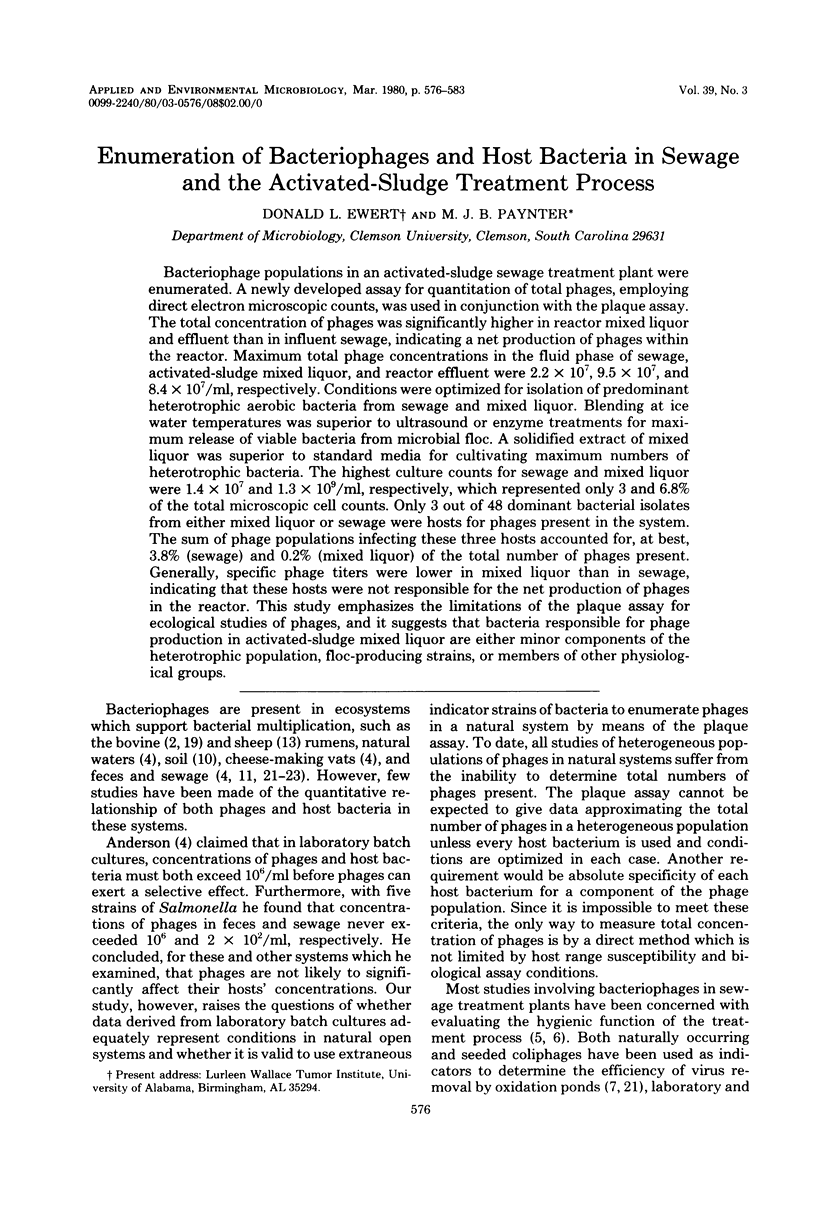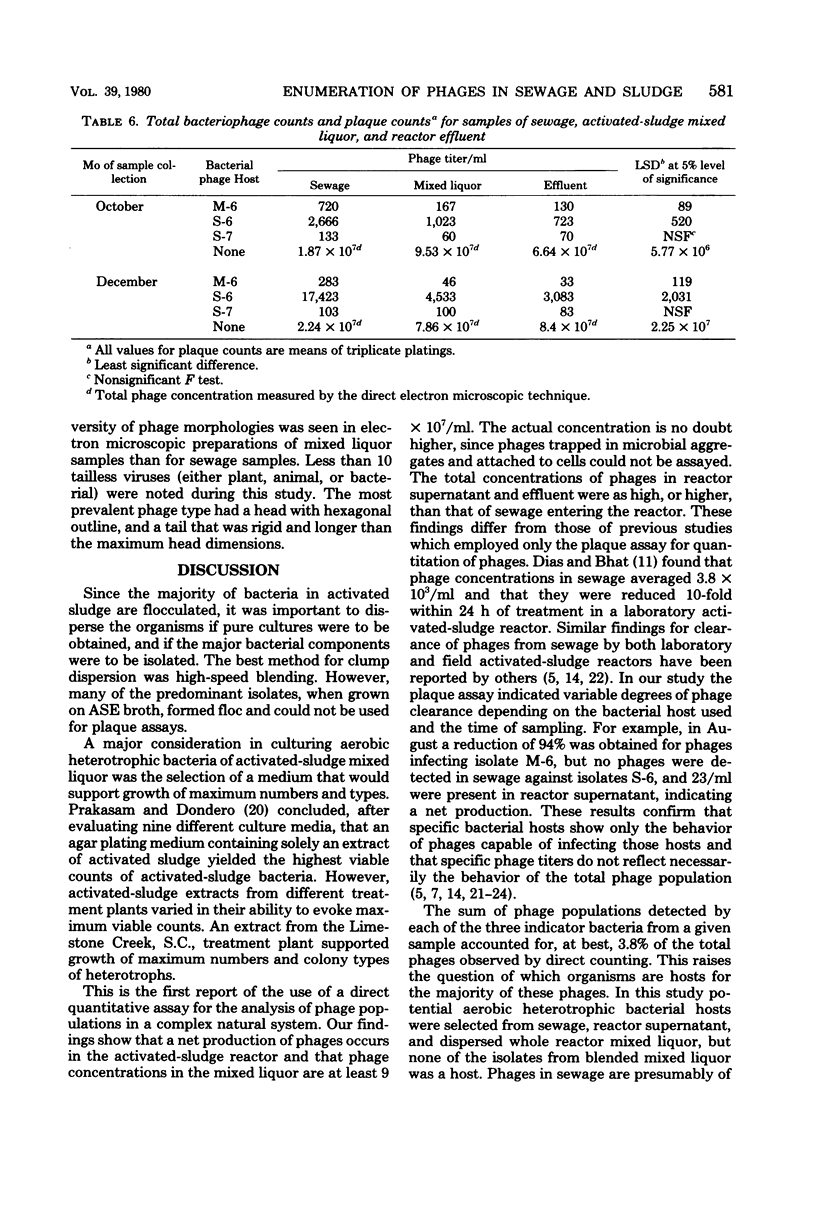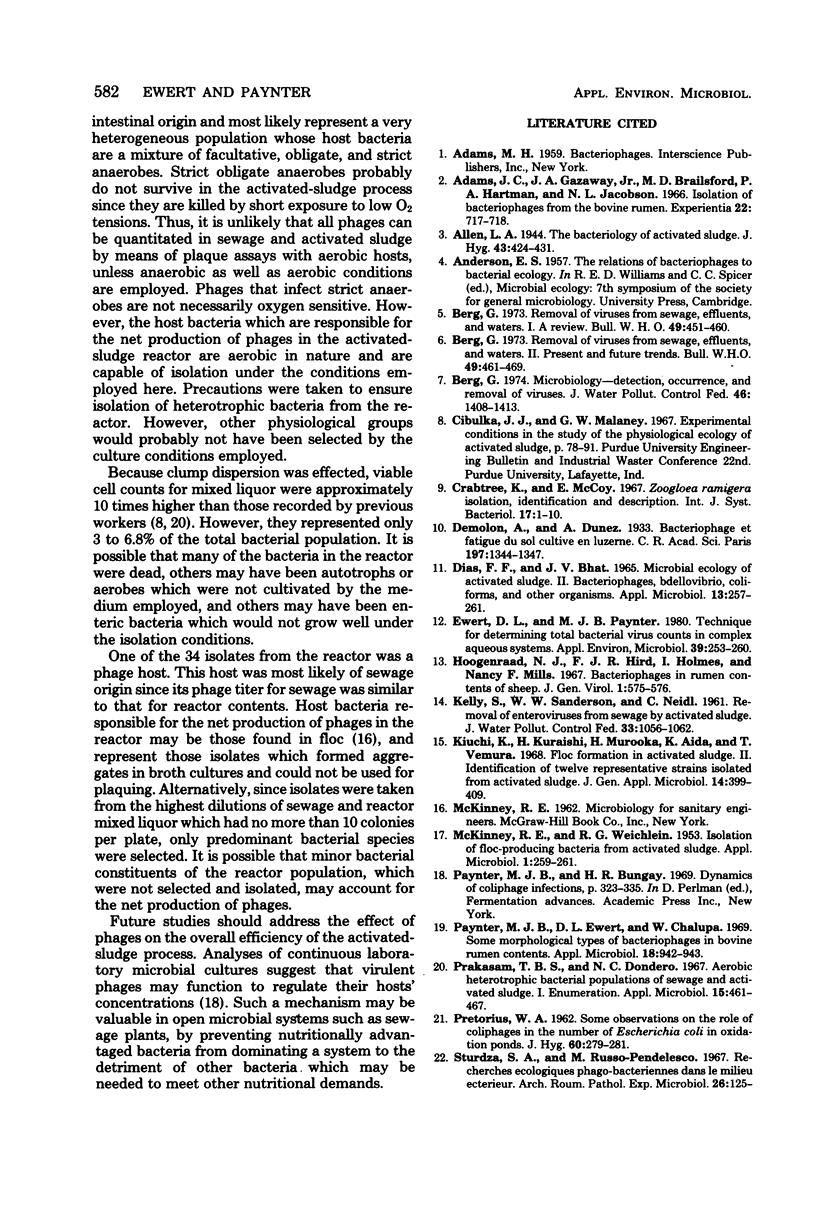Abstract
Bacteriophage populations in an activated-sludge sewage treatment plant were enumerated. A newly developed assay for quantitation of total phages, employing direct electron microscopic counts, was used in conjunction with the plaque assay. The total concentration of phages was significantly higher in reactor mixed liquor and effluent than in influent sewage, indicating a net production of phages within the reactor. Maximum total phage concentrations in the fluid phase of sewage, activated-sludge mixed liquor, and reactor effluent were 2.2 × 107, 9.5 × 107, and 8.4 × 107/ml, respectively. Conditions were optimized for isolation of predominant heterotrophic aerobic bacteria from sewage and mixed liquor. Blending at ice water temperatures was superior to ultrasound or enzyme treatments for maximum release of viable bacteria from microbial floc. A solidified extract of mixed liquor was superior to standard media for cultivating maximum numbers of heterotrophic bacteria. The highest culture counts for sewage and mixed liquor were 1.4 × 107 and 1.3 × 109/ml, respectively, which represented only 3 and 6.8% of the total microscopic cell counts. Only 3 out of 48 dominant bacterial isolates from either mixed liquor or sewage were hosts for phages present in the system. The sum of phage populations infecting these three hosts accounted for, at best, 3.8% (sewage) and 0.2% (mixed liquor) of the total number of phages present. Generally, specific phage titers were lower in mixed liquor than in sewage, indicating that these hosts were not responsible for the net production of phages in the reactor. This study emphasizes the limitations of the plaque assay for ecological studies of phages, and it suggests that bacteria responsible for phage production in activated-sludge mixed liquor are either minor components of the heterotrophic population, floc-producing strains, or members of other physiological groups.
Full text
PDF







Selected References
These references are in PubMed. This may not be the complete list of references from this article.
- Berg G. Removal of viruses from sewage, effluents and waters. 2. Present and future trends. Bull World Health Organ. 1973;49(5):461–469. [PMC free article] [PubMed] [Google Scholar]
- Berg G. Removal of viruses from sewage, effluents, and waters. I. A review. Bull World Health Organ. 1973;49(5):451–460. [PMC free article] [PubMed] [Google Scholar]
- Berg G. Water pollution. Microbiology--detection, occurrence, and removal of viruses. J Water Pollut Control Fed. 1974 Jun;46(6):1408–1413. [PubMed] [Google Scholar]
- DIAS F. F., BHAT J. V. MICROBIAL ECOLOGY OF ACTIVATED SLUDGE. II. BACTERIOPHAGES, BDELLOVIBRIO, COLIFORMS, AND OTHER ORGANISMS. Appl Microbiol. 1965 Mar;13:257–261. doi: 10.1128/am.13.2.257-261.1965. [DOI] [PMC free article] [PubMed] [Google Scholar]
- Ewert D. L., Paynter M. J. Technique for determining total bacterial virus counts in complex aqueous systems. Appl Environ Microbiol. 1980 Jan;39(1):253–260. doi: 10.1128/aem.39.1.253-260.1980. [DOI] [PMC free article] [PubMed] [Google Scholar]
- Hoogenraad N. J., Hirk F. J., Holmes I., Millis N. F. Bacteriophages in rumen contents of sheep. J Gen Virol. 1967 Oct;1(4):575–576. doi: 10.1099/0022-1317-1-4-575. [DOI] [PubMed] [Google Scholar]
- McKINNEY R. E., WEICHLEIN R. G. Isolation of floc-producing bacteria from activated sludge. Appl Microbiol. 1953 Sep;1(5):259–261. doi: 10.1128/am.1.5.259-261.1953. [DOI] [PMC free article] [PubMed] [Google Scholar]
- PRETORIUS W. A. Some observations on the role of coliphages in the number of Escherichia coli in oxidation ponds. J Hyg (Lond) 1962 Sep;60:279–281. doi: 10.1017/s0022172400020374. [DOI] [PMC free article] [PubMed] [Google Scholar]
- Paynter M. J., Ewert D. L., Chalupa W. Some morphological types of bacteriophages in bovine rumen contents. Appl Microbiol. 1969 Nov;18(5):942–943. doi: 10.1128/am.18.5.942-943.1969. [DOI] [PMC free article] [PubMed] [Google Scholar]
- Prakasam T. B., Dondero N. C. Aerobic heterotrophic bacterial populations of sewage and activated sludge. I. Enumeration. Appl Microbiol. 1967 May;15(3):461–467. doi: 10.1128/am.15.3.461-467.1967. [DOI] [PMC free article] [PubMed] [Google Scholar]
- Sturdza S. A., Russu-Pandelesco M. Recherches écologiques phago-bactériennes dans le milieu extérieur. (Un bilan) Arch Roum Pathol Exp Microbiol. 1967 Mar;26(1):125–154. [PubMed] [Google Scholar]
- WARE G. C., MELLON M. A. Some observations on the coli/coliphage relationship in sewage. J Hyg (Lond) 1956 Mar;54(1):99–101. doi: 10.1017/s002217240004434x. [DOI] [PMC free article] [PubMed] [Google Scholar]
- Weber-Schutt G. Experimentelle Studien mit Bakteriophagen in Abwasserkläranlagen unter besonderer Berücksichtigung hygienischer Belange. Zentralbl Bakteriol Orig. 1966 Jun;200(2):212–234. [PubMed] [Google Scholar]
- Yin S. C., Moyer J. E. Use of chemical dispersants in the enumeration of bacteria in activated sludge. Appl Microbiol. 1968 Nov;16(11):1790–1791. doi: 10.1128/am.16.11.1790-1791.1968. [DOI] [PMC free article] [PubMed] [Google Scholar]


